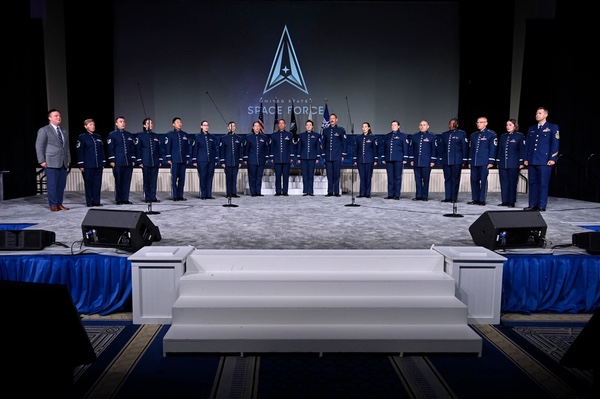The National Cathedral Version of the Space Force Hymn: “Creator of the Universe”by James F. Linzey
|
| To some defense analysts, a hymn might seem peripheral to budgets, launch systems, or satellite constellations. But cultural artifacts—songs, mottos, ceremonies—build identity. |
To signal continuity, I deliberately incorporated echoes of both the Navy and Air Force hymns—referencing “Eternal Father, strong to save” and alluding to the “great spaces of the sky.” In doing so, I framed the Space Force not as a novelty, but as a natural evolution in American defense.
The chaplain behind the verse
My background spans theology, linguistics, and military service. Ordained in the Southern Baptist Convention, I served nearly 24 years as an Army and Air Force chaplain, retiring as a major. I hold a Master of Divinity from Fuller Theological Seminary and completed advanced biblical Greek studies at Westminster Seminary California. I also served as chief editor of the Modern English Version of the Bible.
That background, I contend, was essential. “If you misquote Scripture or drift into bad doctrine, the troops will notice,” I told Christianity Today. “They need accuracy as much as inspiration.”
Recording the National Cathedral Version
Though the hymn originated on a creaky upright piano, it reached its polished form through Dan Kreider, a Florida-based composer, choral conductor, and music minister. Kreider’s recording captured the slow tempo, rich with harmonic texture reminiscent of Ralph Vaughan Williams. The result is not a martial anthem but a reverent petition—fitting for a service whose domain begins 100 kilometers above the Earth.
“It’s like you’re in a cathedral,” I said. “The reverence—they captured it.”
Reception: Applause, curiosity, and a constitutional concern
Since its release, “Creator of the Universe” has reached far beyond Coffeyville. Coverage has appeared in The Coffeyville Journal, The Times Examiner, Montgomery Independent, Black Hills Pioneer, and others. Major evangelical outlets including Christianity Today, Baptist Press, Faith News Network, and Charisma Media have featured the story. Nationally syndicated radio programs aired recordings and interviews during the Independence Day 2024 season.
Not everyone welcomed the hymn. In 2020, a secular advocacy group submitted letters to the Department of Defense, warning that any official performance might violate constitutional boundaries. The Pentagon responded by affirming that the hymn, like other military hymns, remains unofficial and is used only in voluntary religious, patriotic, or cultural contexts. The matter never reached litigation, and chaplains continue to use the hymn in services.
Cultural significance: Why hymns still matter in the orbital age
To some defense analysts, a hymn might seem peripheral to budgets, launch systems, or satellite constellations. But cultural artifacts—songs, mottos, ceremonies—build identity. They humanize a force whose mission unfolds in an environment measured in kelvins.
Technology wins battles; narratives win minds.
When Congress authorized the Space Force in December 2019, critics mocked the move as theatrical. But five years later, Guardians operate cyber defense cells and monitor thousands of objects in orbit. What the service still lacks are traditions—those symbols of continuity and cohesion. The hymn helps fill that void. It casts the Guardians’ mission in moral and even cosmic terms, reminding listeners that outer space is still, in many worldviews, “the heavens.”
The road to a hymnal—and beyond
Will “Creator of the Universe” one day appear in a Department of Defense hymnal alongside the Navy and Air Force hymns, or be arranged for a full military band? I would welcome it, but am content to let the hymn spread organically.
Future verses, I say only half-jokingly, might one day mention cislunar gateways or solar-sail logistics. For now, the hymn retains a purposely timeless prayer of petitioning the “Eternal Father” who “in solitude of sov’reign grace” might grant courage for each flight.
Final measure
Coffeyville’s old piano is silent again, its keys still. The former Dalton Gang Museum awaits renovation. But the melody birthed there now echoes far beyond southeast Kansas—perhaps in a Vandenberg control room, a chapel on Guam, or a small-town Coffeyville church on Veterans Day.
Wherever it is sung, one thing remains true: a prayer is rising—toward worlds beyond the sky.
Note: we are now moderating comments. There will be a delay in posting comments and no guarantee that all submitted comments will be posted.
